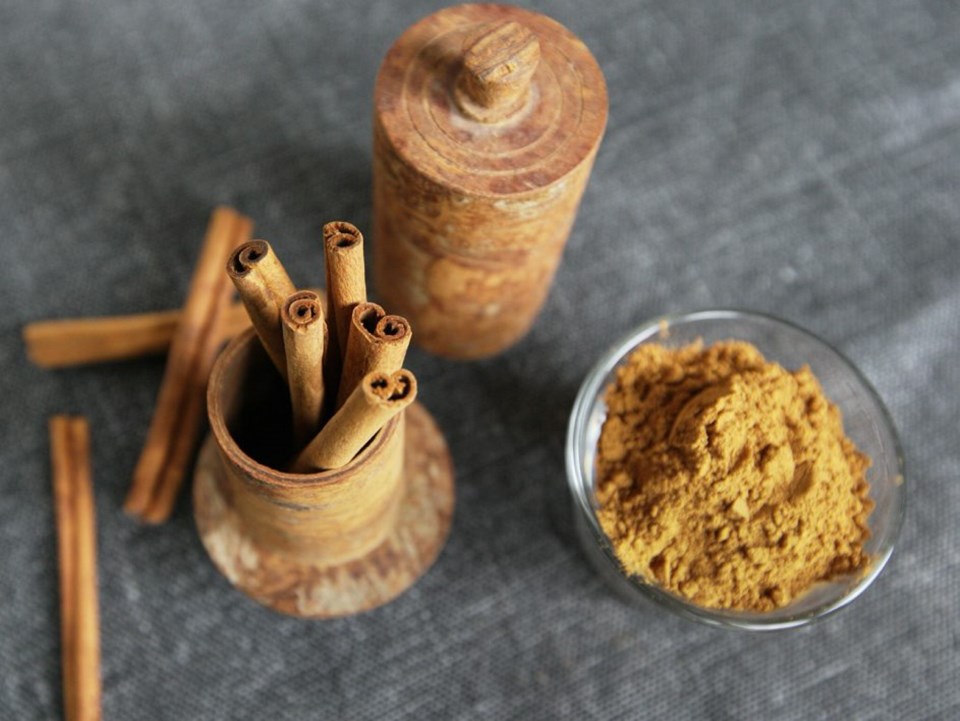Dear Eric: We recently visited Sri Lanka and purchased a package of cinnamon. On returning home, we found the spice to have the aftertaste of cinnamon, but it was gritty and nowhere as sweet as the locally acquired spice. Can you please explain the difference in the two types and how we might effectively use the Sri Lankan type? Dave
Cinnamon is a spice made from the inner bark of various evergreen trees grown in Asia belonging to the genus Cinnamomum. That bark is dried and curls into what are called “quills,” which are sold whole or ground.
Most reference books divide the Cinnamomum genus into two categories, true cinnamon and cassia.
Cassia is more abundant than true cinnamon, and spice company McCormick’s says the most common type is Padang cassia, Cinnamomum burmannii, which is exported in spice form from places such as Indonesia.
That cassia is made from thicker pieces of bark than true cinnamon and has a reddish-brown colour, bold and appealing aroma and a bittersweet flavour. It’s what most Canadians have been using in their recipes for many decades, but one would not know that because here that spice has long been labelled cinnamon, not cassia.
If you have been using that product your whole life, you’ll be shocked if you get a chance to try true cinnamon, which, as Dave noticed, is quite different.
That cinnamon, Cinnamomum verum, is grown in Sri Lanka, is made from much thinner pieces of bark and has a more delicate, almost mysterious flavour and aroma.
A book called the Spice and Herb Bible says it has a light-brown-to-pale-tan colour and when ground into a powder has a very fine, dusty texture. That book says its fragrance is perfumed, warm and pleasantly woody with a taste that has no bitterness or dominating pungency.
Because of those qualities, spice connoisseurs deem it the finest cinnamon, calling cassia just a close relative. But, again, if you have been using the latter type, you’re likely used to its stronger taste and aroma, and might miss those qualities when making baked goods, such as cinnamon buns or coffee cake.
Above, you’ll notice I said: “If you get a chance to try true cinnamon,” also called Ceylon cinnamon. I wrote that because it’s not always easy to find. Trying to change that is Victoria’s Level Ground Trading (levelground.com). This company is probably best-known for the coffee it sells, but now it also sells spices, including Ceylon cinnamon. Stores in Victoria selling it include Lifestyle Markets, Thrifty Foods, Market on Millstream and Forbes IDA Pharmacy on Fort Street.
On the mainland, another place selling Ceylon cinnamon is Vancouver’s Gourmet Warehouse. On its website, gourmetwarehouse.ca., it notes that Ceylon cinnamon can be used to flavour cookies, cakes, stewed fruits, puddings and breads, as well as savoury dishes, such as curries, sauces and vegetable dishes. You’ll see here I used it in a red lentil dahl and it added a fine flavour.
Red Lentil Dahl with Cinnamon, Coconut and Ginger
Serve this aromatic, vegetarian dish as a main course with warm naan or pita bread and steamed basmati rice.
Preparation time: 15 minutes
Cooking time: About 25 to 35 minutes
Makes: Four servings
2 Tbsp vegetable oil
1/2 cup finely chopped onion
1/2 cup finely chopped carrot
1 Tbsp finely chopped fresh ginger
1 medium garlic clove, minced
2 tsp mild or medium curry powder
1/2 tsp ground cinnamon
2 Tbsp tomato paste
1 cup dried split red lentils, rinsed and drained well
1 (14 oz./398 mL) can coconut milk
1 3/4 cups vegetable broth (see Note)
1/4 cup chopped fresh cilantro or mint
• salt to taste
Place the oil in a pot (mine was eight inches wide) set over medium heat. When the oil is hot, add the onion, carrot, ginger and garlic and cook until tender, about four minutes. Mix in the curry powder, cinnamon and tomato paste and cook one minute more.
Add the lentils, coconut milk and broth to the pot and bring to a gentle simmer, adjusting the heat as needed to ensure the mixture just gently bubbles. Cook lentils until tender and the mixture has thickened, about 20 to 30 minutes (see Note). Stir in the cilantro (or mint), season with salt and serve.
Note: I like to taste the lentils after 20 minutes of cooking to see how they are doing, and then continue cooking until they have achieved my desired level of tenderness.
If the lentil mixture becomes too thick, thin it with a bit more broth.
Eric Akis is the author of eight cookbooks. His latest is The Great Rotisserie Chicken Cookbook (Appetite by Random House). His columns appear in the Life section Wednesday and Sunday.



